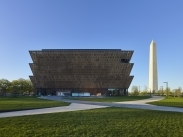Statement on the Tragedy in Charlottesville
We, at the National Museum of African American History and Culture, are saddened by the tragic events in Charlottesville, Va. Our hearts are with the families of the victims—the three who lost their lives, the 35 injured and the millions across the country who are traumatized by this dark chapter in our nation’s history. The violent displays of racism and anti-Semitism are reprehensible. These heinous acts are an assault on our nation’s values and threaten to move our country backward to a time when many had little regard for the principles of fairness, liberty and equality.
Throughout America’s history, we have seen racism and anti-Semitism at work. The terror that shook Charlottesville over the past weekend is the most recent example in a long legacy of violence intended to intimidate and marginalize African Americans and Jews. It is crucial at this time to understand the history of white supremacy as a political ideology and the role of the Ku Klux Klan and other groups in using violence to promote that ideology.
In the 1920s, the Ku Klux Klan counted between 3 and 6 million members. It advocated “One Hundred Percent Americanism” by attacking Jews, Catholics, African Americans and recent immigrants. Acts of violence and intimidation have been their staple strategies. The Klan has been associated with some of the most infamous murders of the 1950s and ’60s, including those of Henrietta and Harry Moore, Medgar Evers, Viola Liuzzo and the bombing of Birmingham’s 16th Street Baptist Church in which four black girls were killed. In the 21st century, Neo-Nazis and other anti-government groups have joined with the Klan in promoting white racial superiority and terrorizing blacks and other minority groups.
Recognizing the history of violence in support of white supremacy is only part of fully understanding the events of recent days. The white supremacists who gathered in Charlottesville announced that they were there to protect a statue of Confederate Gen. Robert E. Lee. We should consider the political context in which these Confederate statues and monuments have been erected.
According to a recent report by the Southern Poverty Law Center, more than 1,500 symbols of the Confederacy can be seen in public spaces in 31 states and the District of Columbia. These include more than 700 monuments and statues on public property (often courthouse lawns) and at least 109 public schools named for prominent Confederates.
Since 1894, there has been a concerted campaign to commemorate the Confederacy through memorialization and education. Organizations like the United Daughters of the Confederacy, founded in 1894 to “perpetuate the memory of our Confederate heroes and the glorious cause for which they fought,” promoted Confederate monuments, museums and educational activities that emphasized states’ rights rather than slavery as the cause of the Civil War.
It is not surprising then to find that the dedication of Confederate monuments spiked in two distinct time periods: the first two decades of the 20th century and the 1950s and ’60s. The first encompassed the years when states were passing Jim Crow laws disenfranchising African Americans and the second corresponds to the modern civil rights movement. These monuments are symbols that tell us less about the actual Civil War but more about the uncivil peace that followed.
It is often easier to take our attention away from the harsh realities of history. At the National Museum of African American History and Culture, we are committed to bringing history—with all of its pain and its promise—front and center. Only when we illuminate the dark corners and tell the unvarnished truth can we learn history’s lessons and bridge the gaps that divide us.
# # #
SI-462-2017
Fleur Paysour
202-633-4761
Linda St. Thomas
202-841-2517

